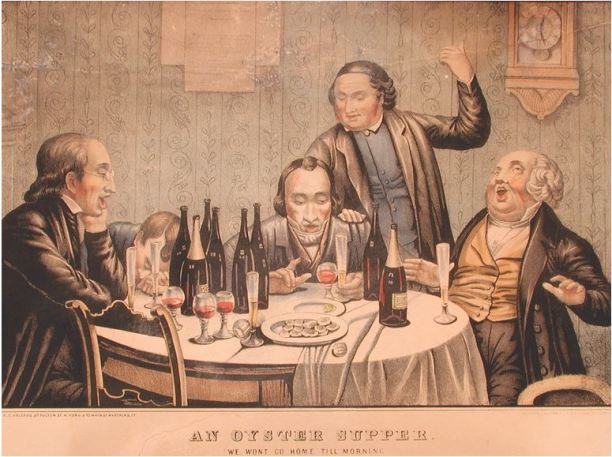By Emily Dunnack
An old myth maintains that you should only eat oysters during months with the letter “R” in their names. This was because of the higher bacteria content—and therefore the greater chance of disease—during summer months and because of the health hazards associated with shipping raw seafood in an age before refrigeration.
Oysters have been a popular food in Connecticut since colonial times and even before. Connecticut’s natural oyster beds are thousands of years old and indigenous people harvested oysters from them long before the colonists arrived. During the 19th century, oysters were an everyday food consumed in great quantities. Early cookbooks contain numerous recipes and different varieties of oysters, and a range of oyster dishes appeared on menus from casual taverns to white-tablecloth restaurants throughout Connecticut.

The Honiss Oyster House, State Street, Hartford, ca. 1920. 1982.80.405a – Connecticut Historical Society
Overfishing in the mid-19th century led to the depletion of Connecticut’s oyster beds, and oysters began being imported from Southern waters. After the passage of a number of laws pertaining to underwater land rights, oyster cultivation became a profitable business in coastal Connecticut. Oyster farmers would put down old oyster shells in an underwater field. Next, oyster “seeds,” or spawning oysters, would be planted and the larvae would attach to the old oyster shells. After about three years, the oysters were ready to be harvested. By the 1880s, Connecticut oyster companies were exporting hundreds of thousands of bushels of oysters each year to Massachusetts, New York, New Jersey, and places as far away as Chicago and Europe.
Of course, many native oysters stayed in the area and made their way to restaurants and home tables across the state. Mark Twain and Buffalo Bill Cody both dined at the historic Honiss Oyster House in Hartford, which opened for business in 1845. When it closed in 1982, Honiss’s was the oldest restaurant in Hartford, a testament to the enduring popularity of the humble oyster. These bivalve molluscs remain popular at local oyster bars today, though at $3 apiece, they are now a luxury food. And thanks to modern technology, oysters now are considered safe to eat any month of the year, whether or not it has an “R” in it.
Emily Dunnack, formerly the Head of Education Programs at the Connecticut Historical Society.
© Connecticut Public Broadcasting Network and Connecticut Historical Society. All rights reserved. This article originally appeared on Connecticut History | WNPR News
Note: ConnecticutHistory.org does not edit content originally published on another platform and therefore does not update any instances of outdated content or language.









